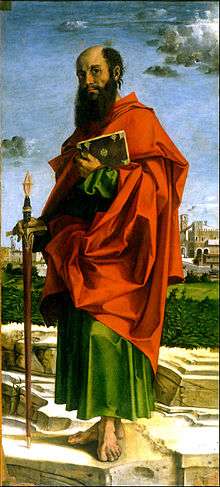Unknown God
The Unknown God or Agnostos Theos (Ancient Greek: Ἄγνωστος Θεός) is a theory by Eduard Norden first published in 1913 that proposes, based on the Christian Apostle Paul's Areopagus speech in Acts 17:23, that in addition to the twelve main gods and the innumerable lesser deities, ancient Greeks worshipped a deity they called "Agnostos Theos", that is: "Unknown God", which Norden called "Un-Greek".[1] In Athens, there was a temple specifically dedicated to that god and very often Athenians would swear "in the name of the Unknown God" (Νὴ τὸν Ἄγνωστον Ne ton Agnoston).[2] Apollodorus, Philostratus[3] and Pausanias wrote about the Unknown God as well.[4] The Unknown God was not so much a specific deity, but a placeholder, for whatever god or gods actually existed but whose name and nature were not revealed to the Athenians or the Hellenized world at large.
Paul at Athens
According to the book of Acts, contained in the Christian New Testament, when the Apostle Paul visited Athens, he saw an altar with an inscription dedicated to that god (possibly connected to the Cylonian affair[5]), and, when invited to speak to the Athenian elite at the Areopagus gave the following speech:
Acts 17:22-31 (KJV): 22 Then Paul stood in the midst of Mars’ hill, and said, Ye men of Athens, I perceive that in all things ye are too superstitious. 23 For as I passed by, and beheld your devotions, I found an altar with this inscription, TO THE UNKNOWN GOD. Whom therefore ye ignorantly worship, him declare I unto you. 24 God that made the world and all things therein, seeing that he is Lord of heaven and earth, dwelleth not in temples made with hands; 25 neither is worshipped with men’s hands, as though he needed any thing, seeing he giveth to all life, and breath, and all things; 26 and hath made of one blood all nations of men for to dwell on all the face of the earth, and hath determined the times before appointed, and the bounds of their habitation; 27 that they should seek the Lord, if haply they might feel after him, and find him, though he be not far from every one of us: 28 for in him we live, and move, and have our being; as certain also of your own poets have said, For we are also his offspring. 29 Forasmuch then as we are the offspring of God, we ought not to think that the Godhead is like unto gold, or silver, or stone, graven by art and man’s device. 30 And the times of this ignorance God winked at; but now commandeth all men every where to repent: 31 because he hath appointed a day, in the which he will judge the world in righteousness by that man whom he hath ordained; whereof he hath given assurance unto all men, in that he hath raised him from the dead.
Because the Jewish God could not be named, it is possible that Paul's Athenian listeners would have considered his god to be "the unknown god par excellence".[6] His listeners may also have understood the introduction of a new god by allusions to Aeschylus' The Eumenides; the irony would have been that just as the Eumenides were not new gods at all but the Furies in a new form, so was the Christian God not a new god but rather the god the Greeks already worshipped as the Unknown God.[7] His audience would also have recognized the quotes in verse 28 as coming from Epimenides and Aratus, respectively.
See also
Notes
- ↑ van der Horst, Pieter Willem (1998). Hellenism, Judaism, Christianity: essays on their interaction. The Altar of the 'Unknown God' in Athens (Acts 17:23) and the Cults of 'Unknown Gods' in the Graeco-Roman World. Peeters Publishers. pp. 187–220. ISBN 9789042905788.
- ↑ Pseudo-Lucian, Philopatris, 9.14
- ↑ Philostratus, Vita Apollonii 6.3
- ↑ Pausanias' Description of Greece in 6 vols, Loeb Classic Library, Vol I, Book I.1.4
- ↑ Plutarch's Lives
- ↑ Tomson, Peter J.; Lambers-Petry, Doris (2003). The image of the Judaeo-Christians in ancient Jewish and Christian literature. Mohr Siebeck. p. 235. ISBN 3-16-148094-5.
- ↑ Kauppi, Lynn Allan (2006). "Acts 17.16-34 and Aeschylus' Eumenides". Foreign but familiar gods: Greco-Romans read religion in Acts. Continuum International Publishing Group. pp. 83–93. ISBN 0-567-08097-8.
